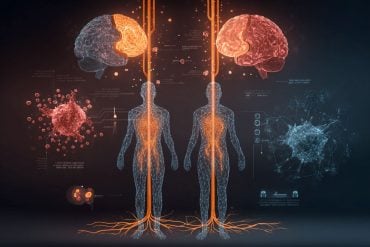Summary: New research uncovers how dopamine in the ventral shell of the nucleus accumbens (vsNAc) governs the sexual behavior sequence in male mice, from sniffing to ejaculation. Using fiber photometry, scientists identified rhythmic dopamine activity during intromission that aligns with movement patterns and is regulated by acetylcholine inputs.
Crucially, the final intromission before ejaculation shows a distinct dopamine signal, and artificial stimulation of acetylcholine neurons during this phase triggers ejaculation. These insights not only deepen understanding of sexual behavior regulation but also hold potential for developing treatments for ejaculatory dysfunction linked to psychiatric conditions and medications.
Key Facts:
- Dopamine Timing: Rhythmic dopamine release in vsNAc tracks behavioral transitions.
- Acetylcholine Link: Acetylcholine neurons modulate dopamine rhythms that trigger ejaculation.
- Clinical Relevance: Findings may lead to new therapies for ejaculatory dysfunction in depression or medication use.
Source: University of Tsukuba
Male mice follow a stereotypical sequence of sexual behaviors, transitioning from initial interaction with an estrous female to ejaculation. This sequence includes sniffing, mounting, and intromission, all of which are crucial for reproductive success.
However, the specific brain mechanisms underlying these behavioral transitions remained unclear until now.
In this study, researchers demonstrated that dopamine, a key neurotransmitter in the brain’s reward system, plays a pivotal role in governing behavioral shifts. Using fiber photometry, they comprehensively measured dopamine input patterns to the nucleus accumbens, a region known for its substantial dopamine input.
Their findings showed that dopamine levels in a specific subregion—the ventral shell of the nucleus accumbens (vsNAc)—were closely linked to behavioral transitions. Furthermore, rhythmic dopamine input to the vsNAc during intromission, which aligns with male movement patterns, was regulated by acetylcholine innervation of the vsNAc.
The study also revealed that the final intromission before ejaculation exhibited a distinct dopamine activity pattern compared to prior intromissions. Artificially stimulating acetylcholine neurons during intromission replicated this dopamine response, directly triggering ejaculation.
These findings provide the first evidence of a specific nucleus accumbens subregion playing a critical role in controlling sexual behavior and ejaculation. Ejaculatory dysfunction is a known side effect of psychiatric disorders such as depression, as well as certain psychotropic medications.
These discoveries open new avenues for developing treatments for ejaculatory disorders and related conditions, potentially improving therapies for patients with psychiatric disorders or medication-induced dysfunction.
Funding: This study was supported by JSPS KAKENHI (JP21J22555 and JP24K23231 to A.M.), JSPS KAKENHI Grant-in-Aid for Scientific Research on Innovative Areas, “Willdynamics” (JP19H05006 to K.S.); AMED under Grant JP21zf0127005 (to Q.L.); the WPI program from Japan’s MEXT, and the New Cornerstone Science Foundation.
About this neuroscience research news
Author: YAMASHINA Naoko
Source: University of Tsukuba
Contact: YAMASHINA Naoko – University of Tsukuba
Image: The image is credited to Neuroscience News
Original Research: Open access.
“Sequential Transitions of Male Sexual Behaviors Driven by Dual Acetylcholine-Dopamine Dynamics” by SAKURAI, Takeshi et al. Neuron
Abstract
Sequential Transitions of Male Sexual Behaviors Driven by Dual Acetylcholine-Dopamine Dynamics
The neural mechanisms underlying the sequential transitions of male sexual behaviors, including mounting, intromission, and ejaculation, remain largely unexplored.
Here, we report that acetylcholine (ACh)-dopamine (DA) dynamics in the ventral shell of the nucleus accumbens (vsNAc) regulate these sexual transitions in male mice.
During intromission, the vsNAc displays a unique pattern of dual ACh-DA rhythms, generated by reciprocal regulation between ACh and DA signaling via nicotinic ACh receptors (nAChRs) and DA D2 receptors (D2Rs).
Knockdown of choline acetyltransferase (ChAT) or D2R in the vsNAc diminishes the occurrence of intromission and ejaculation. Optogenetic manipulations demonstrated that DA signaling maintains sexual behaviors by suppressing D2RvsNAc neurons.
Moreover, ACh signaling promotes the initiation of mounting and intromission and facilitates the intromission-ejaculation transition by inducing a slowdown in DA rhythm.
Together, these findings reveal that coordinated ACh-DA dynamics in the vsNAc play a critical role in orchestrating the sequential transitions of male sexual behaviors.







